Qatar Environment and Energy Research Institute (Qeeri), part of Hamad Bin Khalifa University (HBKU), has begun operating a new horizontal single-axis photovoltaic (PV) tracker (HSAT) system capable of providing real-world data to maximise solar energy generation to provide real-world data related to hot desert climates.
The project is an initiative of the Qeeri Solar Consortium, a collaborative research group involving Qeeri, Kahramaa, and solar companies from across the globe.
Using HSAT technology, the 134-kW system is located at Qeeri’s state-of-the-art Outdoor Test Facility in Education City, close to its PV Reliability Lab. The HSAT system was provided by consortium member Soltec, a Spain-based industry leader in large-scale solar tracking projects. Hanwha Q Cells, Maxeon Solar, TotalEnergies, and Qeeri provided the PV modules for testing.
Dr Veronica Bermudez, senior research director at Qeeri, said: “This is one of the world’s most significant HSAT research projects and we intend to capitalise on its capabilities to produce unique, valuable data to enhance Qatar’s solar energy capabilities. The deployment of the system is a milestone that also enables Qeeri’s Energy Centre to further its research on optimising solar technologies for the challenges of desert conditions.”
The new system is designed with seven rows of trackers and 15 different kinds of PV modules. A unique feature is the different spacings between the tracker rows, which will help determine the optimal HSAT layout for local conditions. Additionally, the use of different PV modules will help determine which technologies perform best in Qatar’s heat, dust, and ground reflectivity. As part of that, the effects of different positions and quantities of modules on the trackers will be studied.
Dr Marc Vermeersch, executive director of Qeeri, commented: “With a total investment of approximately $450,000, the consortium’s operational strategy aims to demonstrate, validate, and accelerate the development of solar energy technologies that are suited to desert conditions, in order to increase the PV energy yield for Qatar and the region.”
Previous research by Qeeri has shown that single-axis trackers in Qatar increase the annual energy production of one-sided PV modules by at least 8%. The new project will focus on the energy increase from using two-sided PV modules – which produce solar power from both the front and back of the panel.
With the installation and operation of the system now underway, Qeeri has begun planning for stage 2. This phase will include data analysis, and enhancements to the HSAT PV tracker system.
The project is an initiative of the Qeeri Solar Consortium, a collaborative research group involving Qeeri, Kahramaa, and solar companies from across the globe.
Using HSAT technology, the 134-kW system is located at Qeeri’s state-of-the-art Outdoor Test Facility in Education City, close to its PV Reliability Lab. The HSAT system was provided by consortium member Soltec, a Spain-based industry leader in large-scale solar tracking projects. Hanwha Q Cells, Maxeon Solar, TotalEnergies, and Qeeri provided the PV modules for testing.
Dr Veronica Bermudez, senior research director at Qeeri, said: “This is one of the world’s most significant HSAT research projects and we intend to capitalise on its capabilities to produce unique, valuable data to enhance Qatar’s solar energy capabilities. The deployment of the system is a milestone that also enables Qeeri’s Energy Centre to further its research on optimising solar technologies for the challenges of desert conditions.”
The new system is designed with seven rows of trackers and 15 different kinds of PV modules. A unique feature is the different spacings between the tracker rows, which will help determine the optimal HSAT layout for local conditions. Additionally, the use of different PV modules will help determine which technologies perform best in Qatar’s heat, dust, and ground reflectivity. As part of that, the effects of different positions and quantities of modules on the trackers will be studied.
Dr Marc Vermeersch, executive director of Qeeri, commented: “With a total investment of approximately $450,000, the consortium’s operational strategy aims to demonstrate, validate, and accelerate the development of solar energy technologies that are suited to desert conditions, in order to increase the PV energy yield for Qatar and the region.”
Previous research by Qeeri has shown that single-axis trackers in Qatar increase the annual energy production of one-sided PV modules by at least 8%. The new project will focus on the energy increase from using two-sided PV modules – which produce solar power from both the front and back of the panel.
With the installation and operation of the system now underway, Qeeri has begun planning for stage 2. This phase will include data analysis, and enhancements to the HSAT PV tracker system.



